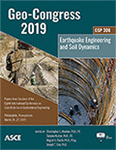Eighth International Conference on Case Histories in Geotechnical Engineering
Seismic Soil-Structure Interaction Response of Tall Buildings
Publication: Geo-Congress 2019: Earthquake Engineering and Soil Dynamics (GSP 308)
ABSTRACT
Significant improvement has been made with the advent of numerical tools and methods in the predicting capabilities of behavior and building performance when an earthquake strikes. Current building designs tend to produce safer structures, being resiliency the most important consideration to minimize indirect losses due to strong earthquakes. This resiliency is quantified in terms of recovery time; the time necessary to achieve a safe operational level for a structure after an earthquake. Performance based earthquake engineering is a probabilistic assessment of building risk and damage frequently used to quantify earthquake-induced losses of structural and non-structural elements. The main goal of this paper is to estimate the intensity measures and engineering demand parameters for a hypothetical tall building located in an urban environment, downtown Los Angeles, including the influence of foundation soils in the building response. Numerical simulations of a hypothetical tall building supported in a mat foundation are performed using the pressure-dependent multi-yield surface constitutive soil model coded in OpenSees. The building is subjected to three earthquakes levels. Based on the building responses and computed peak story horizontal accelerations, maximum inter-story drifts, and settlements, conclusions are drawn about the influence of soil-structure interaction in the response of tall buildings.
Get full access to this article
View all available purchase options and get full access to this chapter.
ACKNOWLEDGEMENTS
Financial support for this work was provided by the National Science Foundation Grant No. CMMI-1563428. The support of Dr. Joy Pauschke and Dr. Richard Fragaszy, program directors at the National Science Foundation, is greatly appreciated.
REFERENCES
Amec. (2012). Geotechnical Data Report. Regional Connector Transit Project. Los Angeles, California.
ASCE. (2013). Minimum Design Loads for Buildings and Other Structures. ASCE standard, American Society of Civil Engineers, Reston, VA.
Baker, J. W. (2011). “Conditional Mean Spectrum: Tool for Ground-Motion Selection.” Journal of Structural Engineering, 137(3), 322–331.
Biot, M. A. (1962). “Generalized Theory of Acoustic Propagation in Porous Dissipative Media.” The Journal of the Acoustical Society of America, 34(9A), 1254–1264.
Dibblee, T. W., and Ehrenspeck, H. E. (1991). “Geologic map of the Hollywood and Burbank (south 1/2) quadrangles, Los Angeles, California. Map Scale: 1:24,000.” Dibblee Geological Foundation.
Elgamal, A., Yang, Z., and Parra, E. (2002). “Computational modeling of cyclic mobility and post-liquefaction site response.” Soil Dynamics and Earthquake Engineering, 22(4), 259–271.
FEMA. (2012). “Seismic Performance Assessment of Buildings.” Fema P-58.
Graves, R. W., and Aagaard, B. T. (2011). “Testing Long-Period Ground-Motion Simulations of Scenario Earthquakes Using the Mw 7.2 El Mayor-Cucapah Mainshock: Evaluation of Finite-Fault Rupture Characterization and 3D Seismic Velocity Models.” Bulletin of the Seismological Society of America, 101(2), 895–907.
Lamar, D. L. (1970). “Geology of the Elysian Park-Repetto Hills area, Los Angeles County, California: California Division of Mines and Geology Special Report 101, map scale 1:24,000.”
Lysmer, J., and Kuhlemeyer, R. L. (1969). “Finite Dynamic Model for Infinite Media.” Engineering Mechanics Division, 95(1882), 167–188.
McKenna, F., Fenves, G. L., Scott, M. H., and Jeremic, B. (2000). “Open System for Earthquake Engineering Simulation (OpenSees).” Pacific Earthquake Engineering Research Center, University of California, Berkeley, CA.
Meyerhof, G. (1957). “Discussion on Research on determining the density of sands by penetration testing.” Proc. 4th Int’l Conference on Soil Mechanics and Foundation Eng., 1, 110.
Miranda, E., and Aslani, H. (2003). Probabilistic Response Assessment for Building-Specific Loss Estimation.
National Institute of Standards and Technology NIST. (2012). Soil-Structure Interaction for Building Structures, Report NIST/GCR 12-917-21.
USGS. (2008). “2008 Interactive Deaggregation, v3.3.1.”
Yang, Z., Elgamal, A., and Parra, E. (2003). “Computational Model for Cyclic Mobility and Associated Shear Deformation.” Journal of Geotechnical and Geoenvironmental Engineering, 129(12), 1119–1127.
Yang, Z., Lu, J., and Elgamal, A. (2008). “OpenSees soil models and solid-fluid fully coupled elements: user’s manual.” San Diego: University of California, (October).
Information & Authors
Information
Published In
Geo-Congress 2019: Earthquake Engineering and Soil Dynamics (GSP 308)
Pages: 118 - 128
Editors: Christopher L. Meehan, Ph.D., University of Delaware, Sanjeev Kumar, Ph.D., Southern Illinois University Carbondale, Miguel A. Pando, Ph.D., University of North Carolina Charlotte, and Joseph T. Coe, Ph.D., Temple University
ISBN (Online): 978-0-7844-8210-0
Copyright
© 2019 American Society of Civil Engineers.
History
Published online: Mar 21, 2019
Published in print: Mar 21, 2019
ASCE Technical Topics:
- Buildings
- Design (by type)
- Earthquake engineering
- Earthquakes
- Engineering fundamentals
- Geohazards
- Geomechanics
- Geotechnical engineering
- High-rise buildings
- Models (by type)
- Numerical models
- Seismic effects
- Seismic tests
- Soil dynamics
- Soil mechanics
- Soil structures
- Soil-structure interaction
- Structural design
- Structural engineering
- Structural safety
- Structures (by type)
- Tests (by type)
Authors
Metrics & Citations
Metrics
Citations
Download citation
If you have the appropriate software installed, you can download article citation data to the citation manager of your choice. Simply select your manager software from the list below and click Download.
